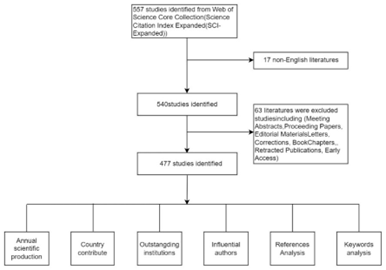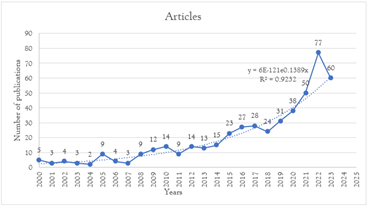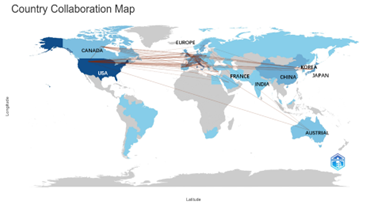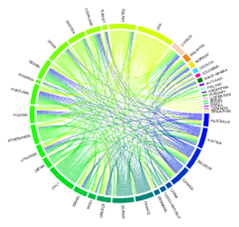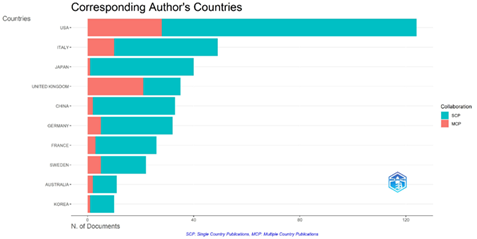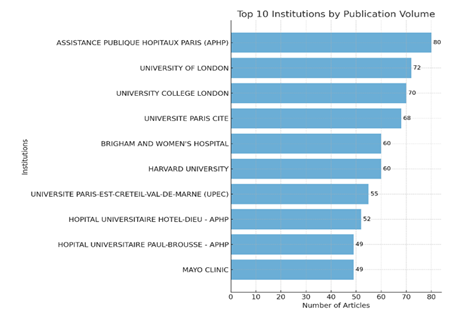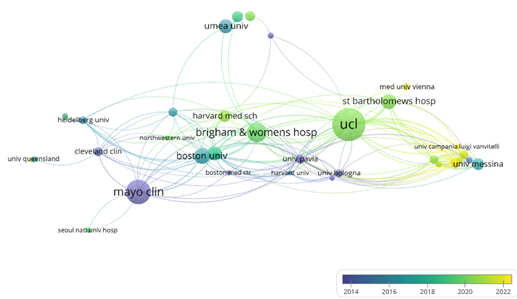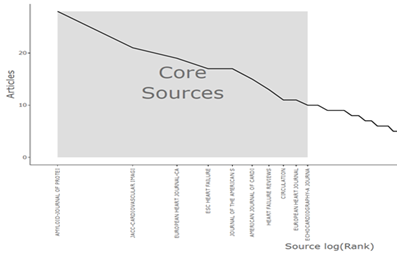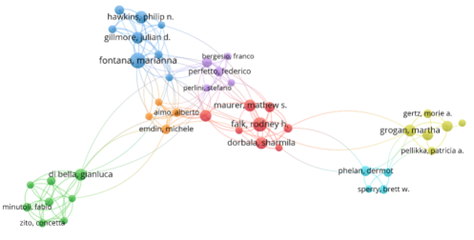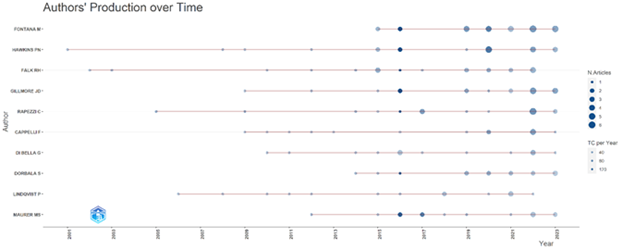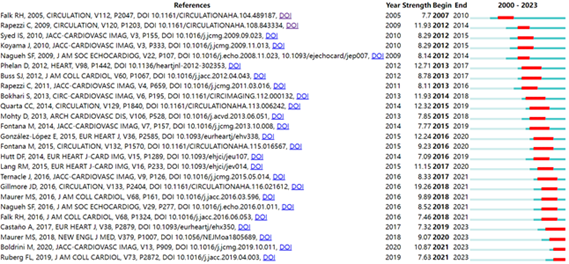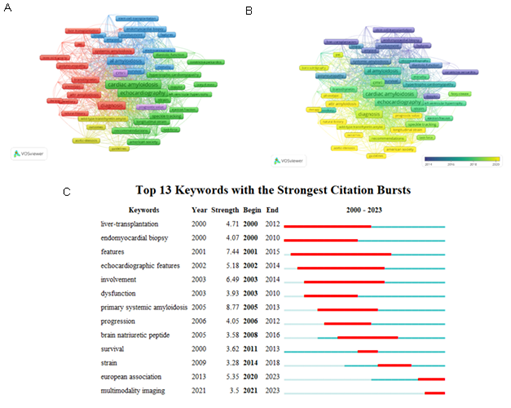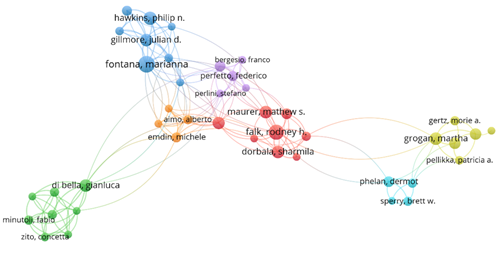Research Article
The Evolution and Scope of Echocardiography on Cardiac Amyloidosis Research: A Bibliometric Analysis
1Department of Ultrasound Imaging, Renmin Hospital of Wuhan University, Wuhan, 430061, China.
2GE Healthcare Ultrasound Clinic Education Team, Wuhan, 430061, China.
*Corresponding Author: Meimei Liao, Department of Ultrasound Imaging, Renmin Hospital of Wuhan University, Wuhan, 430061, China.
Citation: Liao M., Feng C., Guo J. (2024). The Evolution and Scope of Echocardiography on Cardiac Amyloidosis Research: A Bibliometric Analysis, Journal of BioMed Research and Reports, BioRes Scientia Publishers. 5(2):1-11. DOI: 10.59657/2837-4681.brs.24.095
Copyright: © 2024 Juan Guo, this is an open-access article distributed under the terms of the Creative Commons Attribution License, which permits unrestricted use, distribution, and reproduction in any medium, provided the original author and source are credited.
Received: June 26, 2024 | Accepted: July 24, 2024 | Published: July 30, 2024
Abstract
Background: Cardiac Amyloidosis (CA), a major type of systemic amyloidosis, significantly impairs the function of heart and other vital organs. This bibliometric analysis aims to evaluate the evolution and scope of CA research, with a focus on echocardiography, up to November 2023.
Materials and Methods: Articles related to CA and echocardiography were sourced from the Web of Science Core Collection (WOSCC). Data analysis was carried out by R package 'Bibliometrics' for key findings, keyword tracking, and mapping global collaborations analysis. VOS viewer was applied for co-authorship and keyword trend analysis, while Cite Space was used to perform co-cited references analysis.
Results: The study included 477 articles, with the USA, Italy, and France as the predominant contributing countries. Research output showed an increasing annual publication trend, particularly from 2014 onwards. Notable findings include the integration of artificial intelligence in echocardiography and the expansion of multimodal imaging methods. Common keywords included 'cardiac amyloidosis', 'echocardiography', 'machine learning', 'AI'.
Conclusions: This study presents a comprehensive bibliometric analysis of CA research, emphasizing the growing role of echocardiography enhanced by AI and advanced imaging techniques. The findings provide valuable insights for ongoing research and clinical practice in cardio-oncology.
Keywords: cardiac amyloidosis; echocardiography; bibliometrics; CMR; pet; web of science
Introduction
Amyloidosis is a systemic disease that significantly impacts multiple vital organs. Beyond its cardiac implications, primary systemic amyloidosis affects the autonomic and peripheral nerves [1], soft tissues (such as carpal tunnel syndrome, microphthalmia, nail dystrophy, and rash) [2-5], the digestive system (including hepatomegaly and dermatitis) [3], and the kidneys (leading to conditions like nephrotic syndrome and proteinuria) [6]. CA, the most severe form of amyloidosis, accounts for 40% of related fatalities [7]. This condition predominantly manifests in two types: Immunoglobulin AL amyloidosis, caused by aberrant kappa or lambda light chain production from plasma cell dyscrasia, and ATTR amyloidosis, which results from misfolded wild-type (ATTRwt) or variant (ATTRv) transthyretin [8]. ATTRv, an autosomal dominant trait, arises from over 130 mutations in the TTR gene on chromosome 18. With aging populations, ATTRwt-CA is projected to become the most common form of systemic amyloidosis [9].
Echocardiography, the foremost non-invasive imaging modality, is pivotal in visualizing cardiac structure and function. It is particularly crucial in evaluating patients with cardiac symptoms suggestive of CA [10]. Its role in diagnosing, prognosticating, and managing CA has been highlighted in the 2022 ESC Guidelines on cardio-oncology, which endorse it as a class IB diagnostic tool for CA [11].
Bibliometrics, an established approach in academic research evaluation, benefits from the accessibility of scientific databases such as Web of Science (WOS). This approach integrates quantitative and qualitative analyses to reveal the facets of publications, identifying key contributors in research fields and mapping global collaborations. It also aids researchers in understanding the evolution and current trends in specific scientific domains [12]. While there have been limited bibliometric studies on CA, such as an analysis of 2801 articles published from 2000 to 2022 [13]. no study has yet combined CA with echocardiography. To address this gap, our bibliometric analysis intends to construct a comprehensive map of global scientific publications in CA and echocardiography research.
Materials and Methods
Retrieval Strategy and Source of Literature
In this study, we adhered to the STROBE (Strengthening the Reporting of Observational Studies in Epidemiology) guidelines [14]. The Web of Science (WOS), a prominent multidisciplinary literature database globally recognized for bibliometric data collection, was our primary source. A comprehensive search in the WOS Core Collection database, covering literature from January 1, 2000, to November 3, 2023, was conducted. Our search strategy combined medical subject headings with textual words, which were identified from the database housed in the National Library of Medicine (https://www.ncbi.nlm.nih.gov/). The search parameters were set as follows: (Title + Abstract + Keywords = "cardiac amyloidosis" OR "Hereditary Amyloidosis, Transthyretin-Related" OR "Transthyretin Amyloidosis" OR "hereditary transthyretin amyloidosis" OR "Familial Transthyretin Cardiac Amyloidosis" OR “AL cardiac amyloidosis" OR "ATTR cardiac amyloidosis" OR "Light chain amyloid cardiomyopathy" OR "Transthyretin cardiac amyloidosis" OR "amyloid heart disease") AND (Title + Abstract + Keywords = "echocardiography"). The type of literature included: [articles and reviews]; Time span: [from 2000-01-01 to 2023-11-03]; Language selection: [English]; Citation indexes: [SCI-Expanded]. Detailed information about the target publications, including titles, authors, organizations, abstracts, keywords, publication dates, journals, references, and citation numbers, was saved in text file format (".txt").
Bibliometric Analysis
For our bibliometric analysis, three tools were utilized: R version 4.1.3 VOS viewer 1.6., and CiteSpace 6.2.R4 The R package [15] 'bibliometrix' offers functions essential for scientometric and quantitative research. CiteSpace, developed by Professor Chaomei Chen, a globally recognized expert in information visualization, is more than just a citation analysis tool. VOS Viewer16, developed at Leiden University in the Netherlands, is a software tool designed for generating, visualizing, and exploring maps based on bibliometric data.
Results
Publication Summary
Annual publication trend is indicative of trends in a specific research field. From 2000 to November 3, 2023, a total of 477 relevant articles and review articles were identified. A flow chart was presented in Figure 1. This bibliometric analysis, identified 477 documents from 150 sources, exhibiting an annual growth rate of 11.4%. We observed two distinct phases: The Initial Growth Stage (2000-2013) demonstrates a gradual increase in academic interest with annual publications varying from 2 to 14, while the Expansion Stage (2014-2023) reflects a significant upsurge in research activity, reaching its zenith with 77 publications in 2022, as shown in Figure 2.
Figure 1: The flowchart of research.
Figure 2: Trends of annual scientific production on cardiac amyloidosis and echocardiography.
Analysis of the Most Productive Countries and Regions
In total, 43 countries and regions have published articles related to Echocardiography on CA since the new century. International collaboration is illustrated in Figure 3, Supplementary Figure S1. Research collaborations are most common between European, North American, Oceanian, and East Asian countries, with the highest frequency of cooperation between Italy and the UK (frequency = 26), followed by the USA and Italy (frequency = 21), the USA and the UK (frequency = 17), Italy and the Netherlands (frequency = 9), and the USA and Japan (frequency = 7). Additionally, global collaborations on CA research using echocardiography were prominent in the USA (MCP/SCP = 28/96), with other countries such as Italy (MCP/SCP = 10/39), the UK (MCP/SCP = 21/14), and Japan (MCP/SCP = 1/39) also actively involved as shown in Figure S2 and Table 1.
Figure 3: Worldwide distribution of significant international collaborations. Latitude is depicted on the horizontal axis, and longitude is on the vertical axis. Key countries and global regions promoting international research cooperation in cardiac amyloidosis and echocardiography are identified on the map.
Figure S1: International collaboration analysis based on CA on echocardiography publications.
Figure S2: International collaboration analysis based on CA on echocardiography publications.
Table 1: Top 10 Corresponding Author's Countries and collaboration status.
| Country | Articles | SCP | MCP | Freq | MCP Ratio |
| USA | 124 | 96 | 28 | 0.26 | 0.226 |
| Italy | 49 | 39 | 10 | 0.103 | 0.204 |
| Japan | 40 | 39 | 1 | 0.084 | 0.025 |
| United Kingdom | 35 | 14 | 21 | 0.073 | 0.600 |
| China | 33 | 31 | 2 | 0.069 | 0.061 |
| Germany | 32 | 27 | 5 | 0.067 | 0.156 |
| France | 26 | 23 | 3 | 0.055 | 0.115 |
| Sweden | 22 | 17 | 5 | 0.046 | 0.227 |
| Australia | 11 | 9 | 2 | 0.023 | 0.182 |
| Korea | 10 | 9 | 1 | 0.021 | 0.100 |
Analysis of the Most Productive Institutions
725 institutions have been involved in echocardiography research on CA since 2000. Figure 4 displayed the top 10 most productive institutions. Notably, both the United States and France have three or more institutions ranked among the highest in productivity. Co-authorship analysis estimates relationships between different institutions based on the number of coauthored publications. The overlay network of co-authorship analysis shows that the size of the circle indicates the number of publications, and the color represents the average year of publication in each institution's specific research field. As shown in Supplementary Figure S3, 42 institutions were identified. Researchers at the Mayo Clinic in the USA were early contributors to the field of CA research using echocardiography, while University College London has conducted more recent research in this field.
Figure 4: Top 10 Institutions by Scientific Publications since 2000. The x-axis indicates the cumulative number of publications, while the y-axis lists the leading institutions based on their publication count from 2000 onward.
Figure S3: Overlay visualization map of worldwide institutions co-authorship analysis.
Analysis of the Higher-Impact Journals
Bradford's Law illustrates a distribution trend observed in the dissemination of research articles across scientific journals within a specific discipline. It is revealed that a limited number of journals are responsible for publishing the majority of articles, while a greater number of publications feature fewer articles on the topic. Figure 5 presented here effectively captures this trend: rankings of journals are represented on the X-axis, with the number of related articles published delineated on the Y-axis. Journals contributing the most articles on a given subject are highlighted within the 'Core Sources' area, attracting the focus of researchers engaged in literature reviews and information retrieval.
Figure 5: Core Sources by Bradford's Law.
Figure 5 displayed the Core Sources by Bradford's Law. A significant reduction in article publication is noted as one progresses rightward on the X-axis, reflecting lower-ranked journals. This demonstrates the critical role played by a handful of journals, as they amass a substantial portion of research outcomes. Top-tier journals in cardiology, such as the "Journal of the American College of Cardiology" and "Circulation," known for their extensive peer-review process, are recognized for publishing impactful research. Table 2 lists the top 10 journals along with their recent impact factors. The journal with the most publications is 'Amyloid-Journal of Protein Folding Disorders', featuring 28 articles.
Table 2: Top 10 journals with most publications in the field of CA and echocardiography research.
| Ranking | Sources | Articles | Country | IF | JCR-c |
| 1 | Amyloid-Journal of Protein Folding Disorders | 28 | United Kingdom | 4.9 | Q2 |
| 2 | JACC-Cardiovascular Imaging | 21 | United States | 18.4 | Q1 |
| 3 | European Heart Journal-Cardiovascular Imaging | 19 | United Kingdom | 14.9 | Q1 |
| 4 | Esc Heart Failure | 17 | United Kingdom | 5.4 | Q2 |
| 5 | Journal of the American Society of Echocardiography | 17 | United States | 7.1 | Q1 |
| 6 | American Journal of Cardiology | 15 | United States | 3.6 | Q2 |
| 7 | Heart Failure Reviews | 13 | United States | 5.1 | Q2 |
| 8 | Circulation | 11 | United States | 37.8 | Q1 |
| 9 | European Heart Journal | 11 | United Kingdom | 39.3 | Q1 |
| 10 | Echocardiography | 10 | United States | 1.8 | Q4 |
Analysis of the Most Influential Authors
Table 3 presents the top 10 authors with the most publications in the field of CA research in echocardiography. FONTANA M's team/lab was the most productive, publishing 27 articles (H-index = 16), followed by HAWKINS PN with 21 articles (H-index = 15), and FALK RH with 20 articles (H-index = 17). The co-authorship analysis of the domain authors shows that they have relatively many links to other authors in the network, which indicates they are more academically relevant, as shows by Supplementary Figure S4. As illustrated in Figure 6, FALK RH has developed and validated a novel echocardiographic scoring system to assess the degree and type of valvular disease in CA patients. He has provided practical points and recommendations for Echocardiography on CA, demonstrating its usefulness and accuracy in the diagnosis and evaluation of this challenging disease. FONTANA, based in CA, is a notable author in the field of echocardiography research. Despite starting later than others in this area, he has published extensively. His research primarily focuses on exploring the use of echocardiography as a non-invasive diagnostic tool for CA, developing and validating several echocardiographic scores and parameters to help identify and differentiate types of CA, such as transthyretin (TTR) and light chain (AL) amyloidosis. He has also investigated the prognostic implications of echocardiographic findings in CA patients and their response to treatment, contributing significantly to the advancement of knowledge and clinical practice in this field.
Table 3: Top 10 authors with the most publications in the field of CA and echocardiography research.
| Authors | Ranking | Articles | Ranking | H-index |
| FONTANA M | 1 | 27 | 2 | 16 |
| HAWKINS PN | 2 | 21 | 3 | 15 |
| FALK RH | 3 | 20 | 1 | 17 |
| GILLMORE JD | 4 | 19 | 5 | 12 |
| RAPEZZI C | 5 | 18 | 4 | 14 |
| CAPPELLI F | 6 | 14 | 5 | 12 |
| DI BELLA G | 6 | 14 | 6 | 10 |
| DORBALA S | 6 | 14 | 6 | 10 |
| LINDQ14VIST P | 6 | 14 | 6 | 10 |
| MAURE3R MS | 6 | 14 | 6 | 10 |
Figure S4: Network visualization map of author co-authorship analysis.
Figure 6: The author's publication pattern over time. The size of the circles represents the number of publications per year, while the depth of the circle color indicates the annual citation frequency of the articles.
Analysis of Research Hotspots
Most Cited Articles: The frequency of citations in a particular research field can be a valuable indicator of an article's influence. Table 4 listed the top 10 most cited articles, all published between 2000 and 2023, with 30% of them receiving over 100 citations. Furthermore, citations are standardized to allow for fair comparisons across different disciplines or publications. This standardization may include factors such as the average number of citations or the distribution of citations specific to a field or publication, among other considerations. As shown in Table 4, the article titled ‘Nonbiopsy Diagnosis of Cardiac Transthyretin Amyloidosis’ published in 2016 is the top-normalized locally cited article in this field, with normalized local citations of 10.2516. This article's primary contribution is the identification of a new and reliable method for diagnosing cardiac transthyretin amyloidosis (ATTR) using bone scintigraphy, eliminating the need for histological examination. This method demonstrates high sensitivity and specificity, allowing for the diagnosis of cardiac ATTR amyloidosis in most patients without histological confirmation.
Table 4: Top 10 most cited articles on CA on echo since year 2000.
| Document | DOI | Year | Local Citations | Normalized Local Citations |
| PHELAN D, 2012, HEART | 10.1136/heartjnl-2012-302353 | 2012 | 125 | 7 |
| GILLMORE JD, 2016, CIRCULATION | 10.1161/CIRCULATIONAHA.116.021612 | 2016 | 123 | 10.25 |
| PERUGINI E, 2005, J AM COLL CARDIOL | 10.1016/j.jacc.2005.05.073 | 2005 | 102 | 7.4 |
| RAPEZZI C, 2009, CIRCULATION | 10.1161/CIRCULATIONAHA.108.843334 | 2009 | 84 | 4.99 |
| KOYAMA J, 2003, CIRCULATION | 10.1161/01.CIR.0000068313.67758.4F | 2003 | 62 | 2.95 |
| QUARTA CC, 2014, CIRCULATION | 10.1161/CIRCULATIONAHA.113.006242 | 2014 | 59 | 5 |
| SYED IS, 2010, JACC-CARDIOVASC IMAG | 10.1016/j.jcmg.2009.09.023 | 2010 | 55 | 5.5 |
| CASTA O A, 2017, EUR HEART J | 10.1093/eurheartj/ehx350 | 2017 | 54 | 7.64 |
| KOYAMA J, 2010, JACC-CARDIOVASC IMAG | 10.1016/j.jcmg.2009.11.013 | 2010 | 46 | 4.6 |
| TERNACLE J, 2016, JACC-CARDIOVASC IMAG | 10.1016/j.jcmg.2015.05.014 | 2016 | 44 | 3.67 |
Analysis of References with Citation Burst
Figure 7 illustrates the top 25 references with the highest citation burst, with the minimum duration of the burst being 4 years. The blue line represents the observed time interval, while the red line indicates the duration of the burst. Among these articles, the one titled ‘Diagnosis and Management of the Cardiac Amyloidoses’ published in Circulation had the strongest citation burst value during 2007–2010. Furthermore, the citation burst for several articles, such as ‘Cardiac Amyloidosis: Evolving Diagnosis and Management: A Scientific Statement from the American Heart Association’, suggests that the research guidelines pertaining to CA are evolving towards a more comprehensive framework. This evolution is advancing the scholarly maturity of the field, with methodologies for diagnosing and treating this condition increasingly conforming to standardized practices.
Figure 7: Top 25 References with the Strongest Citation Bursts.
Analysis of the Most Frequently Used Keywords
From the total of 1,212 keywords, which encompassed both author keywords and keywords plus, only those with a minimum occurrence of 10 were considered. Based on a previous study, keywords with similar meanings were merged [15]. Ultimately, 71 keywords were retained. Figure 8 shows the network visualization of all keywords. Nodes are sized based on the frequency of keyword occurrence, while their distance reflects their association strength. Nearest-neighbor keywords were clustered together, roughly reflecting CA and echo research areas. Cluster 1, colored in red, delves into the complexities of CA, covering its diagnosis, treatment, and long-term prognosis with a focus on biomarkers and imaging techniques, such as 'cardiac amyloidosis,' 'endomyocardial biopsy,' 'survival.' Cluster 2, in green, encompasses a broad range of cardiovascular diseases, highlighting diagnostic and therapeutic procedures, with a special emphasis on heart failure and echocardiography, such as 'aortic stenosis,' 'heart failure,' 'echocardiography.' Cluster 3, in blue, focuses on ATTR amyloidosis, emphasizing its genetic aspects, systemic impact, and the role of advanced diagnostic techniques and specific treatments, such as 'ATTR amyloidosis,' 'bone scintigraphy,' 'tafamidis.' Cluster 4, in yellow, is centered on advanced cardiac imaging techniques and their application in diagnosing and understanding diverse cardiac conditions, particularly myocardial function and pathology, such as 'CMRI,' 'myocardial fibrosis,' 'tissue doppler.' Cluster 5, in purple, revolves around the standardization and guidelines in cardiology, addressing specific cardiac conditions and the use of advanced imaging in functional assessment, such as 'consensus document,' 'speckle tracking,' 'left atrial function.' An overlay visualization of author keywords is shown in Figure 8B. The keywords appearing earlier are shown in blue, while the more recent keywords are shown in orange. Keywords such as 'constrictive pericarditis,' 'diastolic dysfunction,' 'restrictive cardiomyopathy,' 'stem-cell transplantation,' and 'liver transplantation' were major topics in the early period. In contrast, keywords like 'aortic stenosis,' 'bone scintigraphy,' 'tafamidis' and 'guidelines' have been popular topics in recent years. Figure 8C shows “top 13 keywords with the strongest citation bursts from 2000 - 2023" reflects evolving research priorities in medicine. Early 2000s spikes in "liver transplantation" and "endomyocardial biopsy" point to innovations in these areas. A significant rise in citations for "primary systemic amyloidosis" around 2005 suggests a peak in research interest, potentially due to new treatments. Recent trends show "European association" and "multimodality imaging" as emergent focal points, indicating shifts towards integrated diagnostic approaches and collaboration within Europe.
Figure 8: Analysis of the research hotspots on CA and echo (A, network visualization of all keywords including author keywords and keywords; B, overlay visualization of all keywords; C, Top 13 Keywords with the Strongest Citation Bursts).
Analysis of Hot Trend Topic
Figure 9 shows keywords trend topics analyses results about CA and echocardiography. We summarized the keyword trends from 2010 to 2022 and explored the hotspots in CA and echocardiography, research hotspots have shifted from the early focus on single Tissue Doppler imaging to the current multimodality imaging and the integrated application of machine learning.
Figure 9: keywords trend analyses result about CA and echo since year 2010. The Figure shows the annual top 3 highest-frequency keywords since 2010.
Discussion
This bibliometric analysis study analyzed the development of Echocardiography on CA related research in the past 23years. Articles on Echocardiography on CA showed a growing trend over the past decades, particularly since 2014. The potential reason for the expansion of research might be due to the increasing recognition of the role of echocardiography in the development of CA and, therefore, increased research funding in this field.
The United States stands out with 633 documented studies in cardiac amyloidosis (CA) and echocardiography, underlined by its robust economy and healthcare investments. Journals predominantly from the US and UK lead the publication landscape, with the specialized Amyloid-Journal of Protein Folding Disorders being the most prolific in this niche. The contribution of China and Japan is noteworthy; however, the absence of any East Asian publishers’ points to a regional disparity in the dissemination of research. Among the leading journals, four boast an impact factor (IF) over 10, and six have an H-index above 10, indicating their influence and the quality of published work. The Journal of the American College of Cardiology (JACC)- Cardiovascular Imaging has recently concentrated on CA and echocardiography research. Moreover, Circulation is distinguished by its high citation rate, which reflects its standing in the scientific community and the pertinence of its articles in advancing cardiovascular medicine.
In bibliometric analysis, hotspots signify specific topics in research areas over defined periods. Citation analysis reveals a publication's academic impact, with a focus on highly cited literature to uncover a field's scientific frontiers and current output. This study's top 10 cited articles centered on the diagnostic challenges of differentiating AL and ATTR types, using echocardiography, nuclear scintigraphy, and cardiac MRI. These articles underscore the complexity and variability in assessing cardiac function and prognostic factors in cardiac amyloidosis (CA) [16-20]. Burst detection analysis tracks the evolution of academic hotspots by identifying articles with high citation bursts during specific timeframes. In CA and echocardiography research, there has been a shift from descriptive diagnostic approaches to precise assessment methods, including strain imaging and ventricular wall thickness measurements [21,22]. Recent advancements have developed multi-parametric scoring systems that integrate various parameters for a more accurate depiction of cardiac amyloid infiltration [19]. Recent advancements include the development of multi-parametric scoring systems or diagnostic algorithms that integrate morphological, functional, and strain parameters to reflect the comprehensive impact of cardiac amyloid infiltration more accurately [23]. Additionally, contemporary studies are enhancing diagnosis by combining echocardiography with techniques like (99m) Tc-PYP cardiac scintigraphy, marking a move towards earlier and more accurate CA diagnosis and treatment, highlighting the critical role of echocardiography in CA management [24].
The keywords of the publication are meticulously selected by the authors, reflecting the direction of their research, academic theme, structure of the publication, and its core thesis, thereby delineating the precision and depth of their scholarly work. Statistical analysis of keyword frequency, along with co-occurrence and cluster analyses, serve as indicators of the central themes and emerging trends in CA and echocardiography research in the new century. These methods are crucial for researchers seeking to understand the evolving landscape and hotspots within the field. As revealed through the overlay visualization of author keywords. Moreover, the emergence of the new drug tafamidis has provided more precise and effective treatment for CA. Recently, the publication of guidelines by ASE (American Society of Echocardiography) and ESE (European Society of Echocardiography) on CA has led to more standardized diagnostic and treatment approaches, indicating that the field of CA research has reached a significantly mature phase. Recent research indicated that CA with the deep-learning algorithm showed that the LVH detection model could identify the etiologies of LVH with the AUC, sensitivity, and specificity of 0.98, 94%, and 91.6%, respectively [25].
Broad Spectrum Cardiovascular Pathologies
CA may be present in ≤15% of patients with AS [26]. It was found that 16% of the ATTRwt patients [27] and 9% of AL-CA patients [28] also suffered from AS. In AS patients, CA increases the risk of heart failure, mortality, and treatment futility with aortic valve replacement. Most patients with CA present with diastolic HF with preserved left ventricular ejection fraction (LVEF), but nearly one-third have reduced LVEF [29]. ATTR-CA associated with a severe AS phenotype of low-flow low-gradient with mildly reduced ejection fraction. Deposition of amyloid substance in the walls of the atria often leads to common supraventricular arrhythmias and causes a separation between the electrical and mechanical activities of the atrioventricular region. This condition is linked to a higher risk of blood clots and worsening heart failure [30,31]. The occurrence of conduction disorders, resulting from the infiltration of amyloid in the conduction tissue, is frequently observed during the early stages of the disease [32].
Conventional echocardiographic features of CA
In CA, amyloid buildup thickens the heart's ventricular walls, decreases left ventricle volume, and enlarges both atria, often leading to left ventricular hypertrophy (LVH), the most prevalent echocardiographic sign.These changes can progress to restrictive cardiomyopathy, resulting in complications like pericardial and pleural effusions [33,34]. Almost 5% of those initially diagnosed with hypertrophic cardiomyopathy are reclassified as ATTRm CA after genetic testing [35]. Enlarged left atrium (LA) in ATTR-CA patients may indicate early subclinical changes and diastolic dysfunction, increasing thrombosis risk and elevating right atrium (RA) pressure through changes in the inferior vena cava [36-38]. Valve thickening in CA, often overlapping with aortic stenosis in about 15% of AS patients, leads to hypertrophy and calcification in aortic, mitral, and tricuspid valves. This results in left ventricular hypertrophy and heart failure by impairing ventricular filling and increasing atrial pressures. However, echocardiographic diagnosis of CA is challenging due to the non-specific nature of these ultrasound features [39].
Speckle‑Tracking Echocardiography of CA: Global Longitudinal Strain (LS)
Speckle-tracking echocardiography has enhanced the diagnosis and prognosis of cardiac amyloidosis (CA) using Global Longitudinal Strain (GLS). GLS evaluates amyloid impact across cardiac chambers from the four-chamber view [40], with lower levels in CA-related left ventricular hypertrophy (LVH) linked to adverse cardiovascular outcomes. It surpasses traditional methods in detecting early cardiac function changes and predicting heart disease outcomes [41]. Apical sparing may be observed in CA, characterized by lower GLS in the basal and mid segments, and non-significantly lower LS in the apical segment. Apical sparing indicates amyloid might accumulate more at the heart's base. Even so, apical sparing has a high sensitivity (93%) and specificity (82%), but it is not specific to CA, as it can occur in patients with other infiltrative heart diseases as well, such as Fabry disease [42], Danon disease [43] and end-stage kidney diseases [39].
Myocardial Work
Myocardial work, derived from myocardial strain, evaluates LV deformation and afterload effects to assess cardiac function using the LV pressure-strain loop. This approach more accurately captures early systolic function changes in heart failure patients with preserved ejection fraction (HFpEF) compared to GLS. Studies show that CA patients exhibit a lower LV myocardial work index (LVMWI), which can improve with exercise [44]. A decline in LV myocardial work efficiency (LVMWE) suggests inefficient energy use in CA. Recent research found that global work efficiency (GWE) is lower in AL-CA than in ATTR-CA, indicating greater myocardial dysfunction in AL-CA, with a GWE below 86.5% differentiating between the two types with a sensitivity of 80.0% and specificity of 66.7% [45].
Models for Multiparametric Echocardiography
Conventional echocardiography detected CA with LVEF and mild LVH at high sensitivity (89.7%) and specificity (91.7%) using LVEF/GLS [46]. Scoring systems like AL and IWT were developed to confirm CA diagnoses effectively, correlating with myocardial amyloid content. The ATTR-CM system screens high-risk ATTR-CA patients in the HFpEF group [47]. while the AMYLI system assesses suspected AL-CA and ventricular hypertrophy using relative wall thickness and E/e [48]. In artificial intelligence (AI) applications, AI models excel over humans in echocardiographic analysis by identifying subtle changes with high accuracy. AI facilitates texture analysis for determining LVH causes. and enhances LVH etiology detection through a semi-automatic diagnostic network, improving sensitivity and specificity.
Advanced Cardiac Imaging and Function Analysis
Advancements in imaging techniques have reduced the reliance on endomyocardial biopsy for diagnosing cardiac amyloidosis (CA). Cardiac magnetic resonance imaging (CMRI) with tissue characterization effectively detects myocardial amyloid deposits. As CA progresses, late gadolinium enhancement (LGE) reveals a spectrum of cardiac infiltration from subendocardial to increasingly transmural patterns, mirroring interstitial amyloid deposition. Nuclear scintigraphy serves as a crucial noninvasive tool for monitoring disease progression and distinguishing AL from ATTR CA, with 99mTc-PYP imaging identifying ATTR CA patients. A heart-to-contralateral ratio >1.5 indicates diffuse myocardial tracer retention, achieving 97
Conclusion
In conclusion, research on the role of Echocardiography on CA has received growing attention. A bibliometric analysis was performed using bibliometric software to examine research history on CA and echocardiography since the turn of the century. A total of 477 relevant articles were retrieved from Web of Science. With the highest number of publications, citations, and H index, the United States dominates the field and forms a network of academic collaborations with several European nations (Italy, the UK). A number of other institutions and authors have also made significant contributions to the study of CA, such as the Assistance Publique Hopitaux Paris (APHP), University of London, University College London and Fontana M, Hawkins Pn, Falk Rh. Amyloid-Journal of Protein Folding Disorders was the most productive journaling this research field, while JACC-Cardiovascular Imaging has the highest H-index in this field. AI-enabled deep learning models for ultrasound diagnosis, the treatment of ATTR amyloidosis, multimodality imaging and heart failure will be a hotspot in this field. Our study provides a comprehensive overview of this field of research for new researchers and policymakers.
Declarations
Ethical Approval
Not applicable. This manuscript does not involve any human or animal studies.
Consent to Participate
Not applicable. This manuscript does not involve any human participants.
Consent to Publish
Not applicable. This manuscript does not contain any individual person’s data in any form.
Funding
Not applicable. This study did not receive any specific grant from funding agencies in the public, commercial, or not-for-profit sectors
Author Contributions
Conceptualization, J.G.; methodology, L.M.; software, L.M. and F.C.; validation, L.M. and F.C.; formal analysis, L.M. and J.G.; investigation, L.M and J.G.; resources, L.M. and J.G.; data curation, L.M. and J.G.; writing original draft preparation, L.M. and F.C.; writing and editing, L.M. and J.G.; visualization, J.G.; supervision, J.G.; project administration, J.G. All authors have read and agreed to the published version of the manuscript.
Informed Consent Statement
Patient consent was waived for the reason that this was a retrospective observational study and did not add any costs to patients or do any harm to them.
Conflicts of Interest
The authors declare no conflict of interest.
References
- Kaku M, Berk JL. (2019). Neuropathy Associated with Systemic Amyloidosis. Semin Neurol. 39(5):578-588.
Publisher | Google Scholor - Donnelly JP, Hanna M, Sperry BW, Seitz WH Jr. (2019). Carpal Tunnel Syndrome: A Potential Early, Red-Flag Sign of Amyloidosis. J Hand Surg Am. 44(10):868-876.
Publisher | Google Scholor - Ebert EC, Nagar M. (2008). Gastrointestinal Manifestations of Amyloidosis. Am J Gastroenterol. 103(3):776-787.
Publisher | Google Scholor - Lee AQ, Aronowitz P. (2021). Scalloped Tongue in Primary Amyloidosis. J Gen Intern Med. 36(8):2456-2457.
Publisher | Google Scholor - Barros-Gomes S, Naksuk N, Jevremovic D, Villarraga HR. (2017). A Rash with A Heavy Heart. Echo Res Pract. 4(3):K11–K15.
Publisher | Google Scholor - Owji SM, Raeisi Shahraki H, Owji SH. (2021). A 16-Year Survey of Clinicopathological Findings, Electron Microscopy, And Classification of Renal Amyloidosis. Iran J Med Sci. 46(1):32-42.
Publisher | Google Scholor - Manolis AS, Manolis AA, Manolis TA, Melita H. (2019). Cardiac Amyloidosis: An Underdiagnosed/Underappreciated Disease. Eur J Intern Med. 67:1-13.
Publisher | Google Scholor - Maurer MS, Elliott P, Comenzo R, Semigran M, Rapezzi C. (2017). Addressing Common Questions Encountered in The Diagnosis and Management of Cardiac Amyloidosis. Circulation. 135(14):1357-1377.
Publisher | Google Scholor - Griffin JM, Rosenblum H, Maurer MS. (2021). Pathophysiology And Therapeutic Approaches to Cardiac Amyloidosis. Circ Res. 128(10):1554-1575.
Publisher | Google Scholor - Martinez-Naharro A, Baksi AJ, Hawkins PN, Fontana M. (2020). Diagnostic Imaging of Cardiac Amyloidosis. Nat Rev, Cardiol. 17(7):413-426.
Publisher | Google Scholor - Lyon AR, López-Fernández T, Couch LS, et al. (2022). 2022 ESC Guidelines on Cardio-Oncology Developed in Collaboration with The European Hematology Association (EHA), The European Society for Therapeutic Radiology and Oncology (ESTRO) and the International Cardio-Oncology Society (IC-OS). Eur Heart J. 43(41):4229-4361.
Publisher | Google Scholor - Song Y, Chen X, Hao T, Liu Z, Lan Z. (2019). Exploring Two Decades of Research on Classroom Dialogue by Using Bibliometric Analysis. Comput Educ. 137:12-31.
Publisher | Google Scholor - Fu Z, Lv J, Gao X, et al. (2023). Research Trends and Hotspots Evolution of Cardiac Amyloidosis: A Bibliometric Analysis From 2000 To 2022. Eur J Med Res. 28(1):89.
Publisher | Google Scholor - Von Elm E, Altman DG, Egger M, Pocock SJ, Gotzsche PC, et al. (2007). The Strengthening the Reporting of Observational Studies in Epidemiology (STROBE) Statement: Guidelines for Reporting Observational Studies. Prev Med. 45(4):247-251.
Publisher | Google Scholor - Wu H, Cheng K, Guo Q, et al. (2021). Mapping Knowledge Structure and Themes Trends of Osteoporosis in Rheumatoid Arthritis: A Bibliometric Analysis. Front Med. 8:787228.
Publisher | Google Scholor - Castano A, Narotsky DL, Hamid N, et al. (2017). Unveiling Transthyretin Cardiac Amyloidosis and Its Predictors Among Elderly Patients with Severe Aortic Stenosis Undergoing Transcatheter Aortic Valve Replacement. Eur Heart J. 38(38):2879-2887.
Publisher | Google Scholor - Ternacle J, Bodez D, Guellich A, et al. (2016). Causes And Consequences of Longitudinal LV Dysfunction Assessed By 2D Strain Echocardiography in Cardiac Amyloidosis. JACC Cardiovasc Imaging. 9(2):126-138.
Publisher | Google Scholor - Quarta CC, Solomon SD, Uraizee I, et al. (2014). Left Ventricular Structure and Function in Transthyretin-Related Versus Light-Chain Cardiac Amyloidosis. Circulation. 129(18):1840-1849.
Publisher | Google Scholor - Phelan D, Collier P, Thavendiranathan P, et al. (2012). Relative Apical Sparing of Longitudinal Strain Using Two-Dimensional Speckle-Tracking Echocardiography Is Both Sensitive and Specific for The Diagnosis of Cardiac Amyloidosis. Heart (Br Card Soc). 98(19):1442-1448.
Publisher | Google Scholor - Syed IS, Glockner JF, Feng D, Araoz PA, Martinez MW, et al. (2010). Role of Cardiac Magnetic Resonance Imaging in The Detection of Cardiac Amyloidosis. JACC Cardiovasc Imaging. 3(2):155-164.
Publisher | Google Scholor - Koyama J, Falk RH. (2010). Prognostic Significance of Strain Doppler Imaging in Light-Chain Amyloidosis. JACC Cardiovasc Imaging. 3(4):333-342.
Publisher | Google Scholor - Falk RH. (2005). Diagnosis And Management of The Cardiac Amyloidosis. Circulation. 112(13):2047-2060.
Publisher | Google Scholor - Boldrini M, Cappelli F, Chacko L, et al. (2020). Multiparametric Echocardiography Scores for The Diagnosis of Cardiac Amyloidosis. JACC Cardiovasc Imaging. 13(4):909-920.
Publisher | Google Scholor - Fontana M, Banypersad SM, Treibel TA, et al. (2014). Native T1 Mapping in Transthyretin Amyloidosis. JACC Cardiovasc Imaging. 7(2):157-165.
Publisher | Google Scholor - Yu X, Yao X, Wu B, et al. (2022). Using Deep Learning Method to Identify Left Ventricular Hypertrophy on Echocardiography. Int J Cardiovasc Imaging. 38:759-769.
Publisher | Google Scholor - Ternacle J, Krapf L, Mohty D, et al. (2019). Aortic Stenosis and Cardiac Amyloidosis: JACC Review Topic of The Week. J Am Coll Cardiol. 74(21):2638-2651.
Publisher | Google Scholor - Sperry BW, Jones BM, Vranian MN, Hanna M, Jaber WA. (2016). Recognizing Transthyretin Cardiac Amyloidosis in Patients with Aortic Stenosis: Impact on Prognosis. JACC Cardiovasc Imaging. 9(7):904-906.
Publisher | Google Scholor - Peskó G, Jenei Z, Varga G, et al. (2019). Coexistence of Aortic Valve Stenosis and Cardiac Amyloidosis: Echocardiographic and Clinical Significance. Cardiovasc Ultrasound. 17(1):32.
Publisher | Google Scholor - González-López E, Gallego-Delgado M, Guzzo-Merello G, et al. (2015). Wild-Type Transthyretin Amyloidosis as A Cause of Heart Failure with Preserved Ejection Fraction. Eur Heart J. 36(38):2585-2594.
Publisher | Google Scholor - Feng D, Edwards WD, Oh JK, et al. (2007). Intracardiac Thrombosis and Embolism in Patients with Cardiac Amyloidosis. Circulation. 116(21):2420-2426.
Publisher | Google Scholor - Feng D, Syed IS, Martinez M, et al. (2009). Intracardiac Thrombosis and Anticoagulation Therapy in Cardiac Amyloidosis. Circulation. 119(18):2490-2497.
Publisher | Google Scholor - González-López E, Gagliardi C, Dominguez F, et al. (2017). Clinical Characteristics of Wild-Type Transthyretin Cardiac Amyloidosis: Disproving Myths. Eur Heart J. 38(24):1895-1904.
Publisher | Google Scholor - Sharma N, Howlett J. (2013). Current State of Cardiac Amyloidosis. Curr Opin Cardiol. 28(2):242-248.
Publisher | Google Scholor - Zhang L, Zhou X, Wang J, et al. (2017). Differentiation Of Light-Chain Cardiac Amyloidosis from Hypertrophic Cardiomyopathy Using Myocardial Mechanical Parameters by Velocity Vector Imaging Echocardiography. Int J Cardiovasc Imaging. 33(4):499-507.
Publisher | Google Scholor - Damy T, Costes B, Hagège AA, et al. (2016). Prevalence And Clinical Phenotype of Hereditary Transthyretin Amyloid Cardiomyopathy in Patients with Increased Left Ventricular Wall Thickness. Eur Heart J. 37(23):1826-1834.
Publisher | Google Scholor - Minamisawa M, Inciardi RM, Claggett B, et al. (2021). Left Atrial Structure and Function of The Amyloidogenic V122I Transthyretin Variant in Elderly African Americans. Eur J Heart Fail. 23(8):1290-1295.
Publisher | Google Scholor - El-Am EA, Ahmad A, Dispenzieri A, Grogan M, Nkomo VT. (2021). Cardiac Amyloidosis in Patients with Persistent Left Atrial Thrombus. J Am Coll Cardiol. 78(13):e87.
Publisher | Google Scholor - Berthelot E, Jourdain P, Bailly MT, et al. (2020). Echocardiographic Evaluation of Left Ventricular Filling Pressure in Patients with Heart Failure with Preserved Ejection Fraction: Usefulness of Inferior Vena Cava Measurements And 2016 EACVI/ASE Recommendations. J Card Fail. 26(6):507-514.
Publisher | Google Scholor - Galat A, Guellich A, Bodez D, Slama M, Dijos M, et al. (2016). Aortic Stenosis and Transthyretin Cardiac Amyloidosis: The Chicken or The Egg? Eur Heart J. 37(47):3525-3531.
Publisher | Google Scholor - Kado Y, Obokata M, Nagata Y, et al. (2016). Cumulative Burden of Myocardial Dysfunction in Cardiac Amyloidosis Assessed Using Four-Chamber Cardiac Strain. J Am Soc Echocardiogr. 29(11):1092-1099.e2.
Publisher | Google Scholor - Bravo PE, Fujikura K, Kijewski MF, et al. (2019). Relative Apical Sparing of Myocardial Longitudinal Strain Is Explained by Regional Differences in Total Amyloid Mass Rather Than the Proportion of Amyloid Deposits. JACC Cardiovasc Imaging. 12(7-Pt-1):1165-1173.
Publisher | Google Scholor - Suwalski P, Klingel K, Landmesser U, Heidecker B. (2020). Apical Sparing on Speckle Tracking in Morbus Fabry. Eur Heart J. 41(36):3486.
Publisher | Google Scholor - Bui QM, Hong KN, Kraushaar M, et al. (2020). Apical Sparing Strain Pattern in Danon Disease: Insights from A Global Registry. JACC Cardiovasc Imaging. 13(12):2689-2691.
Publisher | Google Scholor - Clemmensen TS, Eiskjær H, Mikkelsen F, et al. (2020). Left Ventricular Pressure-Strain-Derived Myocardial Work at Rest and During Exercise in Patients with Cardiac Amyloidosis. J Am Soc Echocardiogr. 33(5):573-582.
Publisher | Google Scholor - Palmiero G, Rubino M, Monda E, et al. (2021). Global Left Ventricular Myocardial Work Efficiency in Heart Failure Patients with Cardiac Amyloidosis: Pathophysiological Implications and Role in Differential Diagnosis. J Cardiovasc Echogr. 31(3):157-164.
Publisher | Google Scholor - Pagourelias ED, Mirea O, Duchenne J, et al. (2017). Echo Parameters for Differential Diagnosis in Cardiac Amyloidosis: A Head-To-Head Comparison of Deformation and Non deformation Parameters. Circ, Cardiovasc Imaging. 10(3):e005588.
Publisher | Google Scholor - Davies DR, Redfield MM, Scott CG, et al. (2022). A Simple Score to Identify Increased Risk of Transthyretin Amyloid Cardiomyopathy in Heart Failure with Preserved Ejection Fraction. JAMA Cardiol. 7(10):1036-1044.
Publisher | Google Scholor - Aimo A, Chubuchny V, Vergaro G, et al. (2021). A Simple Echocardiographic Score to Rule Out Cardiac Amyloidosis. Eur J Clin Invest. 51(5):e13449.
Publisher | Google Scholor

